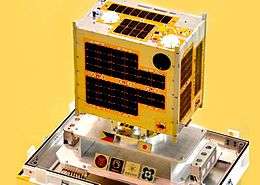Diwata-2
| Mission type | Communications / Earth Observation |
|---|---|
| Spacecraft properties | |
| Manufacturer |
DOST University of the Philippines Hokkaido University Tohoku University |
| BOL mass | 50 kg (110 lb) |
| Start of mission | |
| Launch date | December 2018 |
| Rocket | Vega (rocket) |
| Launch site | Kourou SLV |
| Orbital parameters | |
| Reference system | Sun-synchronous orbit |
| Regime | Low Earth |
| Instruments | |
|
High Precision Telescope (HPT) Space-borne Multispectral Imager (SMI) (with Liquid Crystal Tunable Filter (LCTF)) Enhanced Resolution Cameras Amateur Radio | |
|
Philippine Scientific Earth Observation Microsatellite program | |
Diwata-2 is a Philippine microsatellite under-development and scheduled to be launched in 2018. It will be the second satellite of the Philippine Scientific Earth Observation Microsatellite (PHL-Microsat) program after Diwata-1.
Development
The satellite was developed by 11 scholars under the Philippine Department of Science and Technology (DOST), in cooperation with the Tohoku University and Hokkaido University in contrast to 9 DOST scholars who worked with Diwata-1, Diwata-2's predecessor.[1]
Unlike its predecessor, Diwata-2 will take advantage of radio communication technology by carrying an amateur radio payload for disaster relief purposes.[1] The satellite will also host all embedded features of its predecessor.[2]
Instruments
Diwata-2 will host an amateur radio payload which will enable people in the Philippines to relay messages through ham radio to any part of the country. This function is meant for disaster relief operations. The satellite will also carry Spaceborne Multispectral Imager (SMI) with liquid crystal tunable filter (LCTF) for environmental monitoring, and a high precision telescope (HPT) for rapid post-disaster assessment. Compared to Diwata-1 which hosted wide and middle field cameras, Diwata-2 will host enhanced resolution cameras.[1]
Launch and mission
The satellite was targeted by the DOST to be deployed within the second quarter of 2018.[3] As of March 2018, the satellite is planned to be launched sometime in December 2018.[4]
It will have the same mission as its predecessor, Diwata-1. It will have a sun-synchronous orbit.[3] Unlike Diwata-1, Diwata-2 will be directly deployed from the rocket that it will be hosted on and not from the International Space Station.[4]
See also
References
- 1 2 3 Mondonedo-Ynot, Laureen (18 January 2017). "Diwata 2's payload includes amateur radio". Sun Star Manila. Retrieved 25 January 2017.
- ↑ Sambalud, Mark (7 December 2016). "Change is coming (1/2): How space technology is changing disaster risk management in PHL". Davao Today. Retrieved 25 January 2017.
- 1 2 Usman, Edd (5 June 2017). "How Diwata-2 is better than PH's first satellite, Diwata-1". Rappler. Retrieved 6 June 2017.
- 1 2 Yee, Jovic (19 February 2018). "Pinoy students fail to reach astronauts at space station". Philippine Daily Inquirer. Retrieved 2 June 2018.
.jpg)
